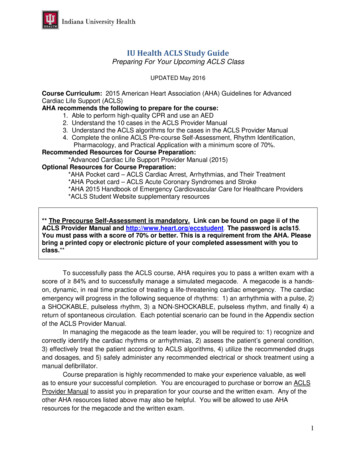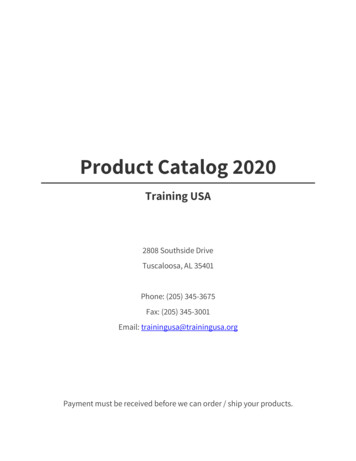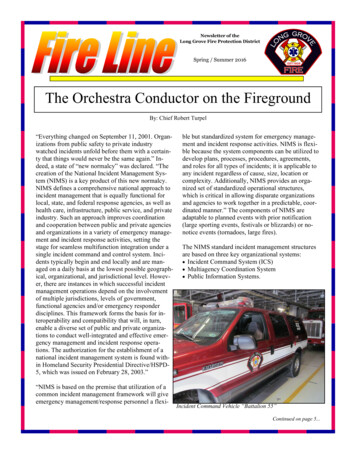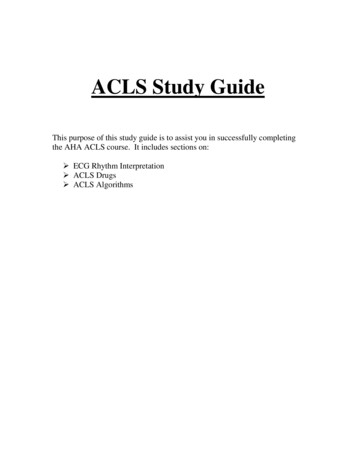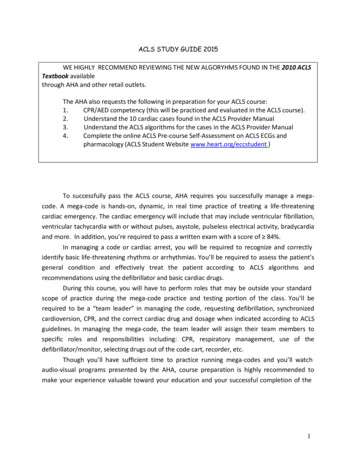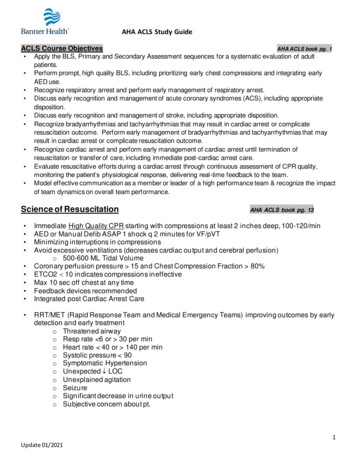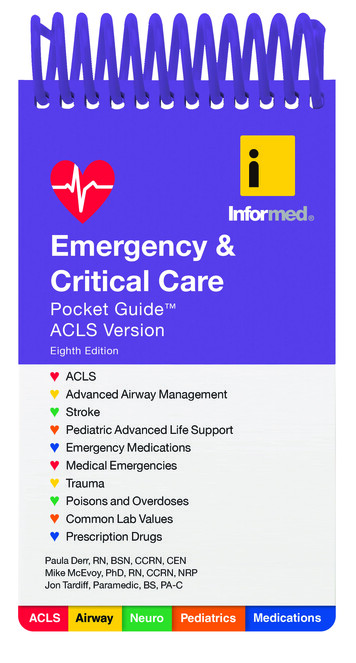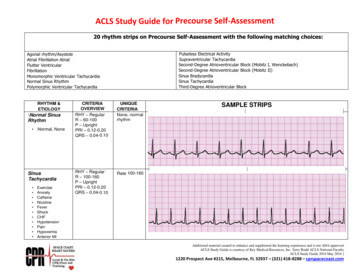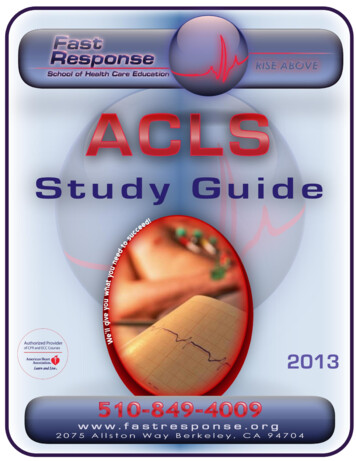
Transcription
ACLS Review – 2015 GuidelinesBLS CPRBLS CPR changes 2015. The primary change is from the “ABC” format to “CAB.” After establishingunresponsiveness and calling for a code, check for a pulse less than 10 seconds then begincompressions immediately, within 10 seconds of arriving at the patient’s side. After thirtycompressions, give your first two breaths. The 30:2 ratio then will continue.Here are the basic steps in BLS:1.2.3.4.5.Check for responsivenessCall for help and an AEDCheck for pulse and simultaneously scan the chest for breathing.Begin the thirty compressions (within 10 seconds of arriving at the patient)Give two breaths—continue 30:2 ratio.High Quality CPR includes:1.2.3.4.5.6.Effective compressions at least 100/min, no more than 120/minMinimal interruptions ( 10secs)Allow for recoil, monitoring via capnography *less than 10 is ineffectiveAt least 2 inch compression depthRotate q2mins/5cyclesChest Compression Fraction (CCF) at least 60%, goal of greater than 80%Defibrillate early (use AED)1.2.3.4.5.Turn on AEDPlace AED PadsAnalyze RhythmConsider Compressions to prep the tissueDefibrillate ‐ SHOCK
AirwayPulse Oximetry to be between 94 – 99% to avoid hyperoxia (high oxygen tension can lead totissue deathWaveform Capnography (pETCO2)Best way to evaluate advanced airway placementCan assist in measuring cardiac output during CPRETCO2 reading must be greater than 10 during CPR ( 10) or patient will notsurviveNormal readings for pETCO2 for patients should be 35‐40Ventilations with Bag Valve Mask (BVM) – breaths every 6 sec (10 breaths per minute)Ventilations with Advanced Airway – breaths every 6 sec (10 breaths per minute)Sinus Bradycardia(Sinus rhythm with a rate less than 50)Is your patient stable or unstable?Stable‐ monitor closelyUnstable/ Symptomatic – this patient is showing signs of poor perfusion (their heart rate is not fastenough to deliver an adequate volume of blood to the body and requires treatment/intervention) for example: hypotensive feels faint, decreased or altered mental status, coolor clammy/diaphoretic.Administer 0.5mg Atropine. If Atropine is ineffective you now have four options:1.2.3.4.Repeat Atropine 0.5 mg (dosing 0.5mg – 1 mg, max total dose 3mg)administer Dopamine 2‐20 mcg/kg/minute ORAdminister Epinephrine infusion: 2 – 10 mcg per minutePrepare and provide external transcutaneous pacing.
Heart BlocksIs your patient stable or unstable?Stable‐ monitor closely, seek expert consultationUnstable/ Symptomatic – this patient is showing signs of poor perfusion (their heart rate is not fastenough to deliver an adequate volume of blood to the body and requires treatment/intervention) for example: low B/P, feels faint, decreased or altered mental status, cool orclammy/diaphoreticAdminister 0.5mg Atropine. But don’t rely on atropine in Mobitz type II, second‐degree block or third‐degree block with a new wide QRS complex.For an unstable Mobitz type II second‐degree or third‐degree heart block patient be prepared fortranscutaneous pacingSupraventricular Tachycardia‐ SVT (SUSTAINED rapid narrow complex tachycardia with a rate greater than 150)Is your patient stable or unstable?Stable‐ Attempt vagal maneuversIf vagal maneuvers aren’t successful in slowing their heart rate, administer 6 mg of Adenosine.Adenosine is that it is a fast‐push and fast‐acting drug. It may cause a short period ofasystole. Patient also must be monitored.If the first dose of 6 mg isn’t successful, ACLS allow you to repeat the Adenosine providing 12 mg thesecond time if needed.
SVT (continued)Unstable/ Symptomatic – this patient is showing signs of poor perfusion (low B/P, feels faint, decreasedor altered mental status, cool or clammy/diaphoretic) it may be due to their heart rate istoo fast to deliver an adequate volume of blood to the body and requires rapid treatment/intervention. Provide synchronized cardioversion of 50 – 100 joules.Monomorphic Ventricular Tachycardia‐ VTVT (SUSTAINED) 30 seconds rapid wide complex tachycardia)First and important question: Does your patient have a pulse with this rhythm?If yes, he/she does have a pulse, then is your patient stable?With a PULSE and UNSTABLE (low B/P, ischemic chest pain, weak, clammy, cold, ashen, unresponsive orlethargic)Deliver immediate synchronized cardioversion at 100J (or higher).Evaluate the rhythm post cardioversion and consider a second attempt at a higher energy level ifneeded.With a PULSE and STABLE, treat with adenosine only if regular and monomorphic.Consider antiarrhythmic infusion i.e. Procainamide or Amiodarone IV drip.Polymorphic Ventricular Tachycardia‐ VTTorsades de PointesArrhythmias with a polymorphic QRS appearance, torsades de pointes for example, will usually notpermit synchronization. The patient will have to be treated as V‐fib: defibrillate at 200 joules.
If there is doubt about whether an unstable patient has monomorphic or polymorphic VT, do not delaytreatment for further rhythm interpretation. Provide defibrillation (not synchronizedcardioversion) at 200 joules.VENTRICULAR FIBRILLATION‐VFib is a chaotic and disorganized rhythm that generates absolutely no perfusion! The heart is quiveringas it is dying and requires IMMEDIATE defibrillation do not delay! The sooner the heart in VFcan be defibrillated, the higher the chances of successfully converting to an organized rhythm.Quickly .1. Rapidly assemble your team2. Begin chest compressions3. Apply defibrillator (hands‐free) pads to patient, clear your co‐workers from touching thepatient or the bed and deliver 200J shock as quickly as you can. Hands freedefibrillation allows for rapid defibrillation. Ensure oxygen sources areImmediately after the shock is delivered, resume compressions and bag mask ventilations. (CPR shouldnot stop for more than 10 seconds.)You will continue CPR for 2 minutes (make sure your timer/recorder is tracking this for you) and prepareyour first drug – your first medication will be Epinephrine 1mg, but do not administer it yet. Thisis also a good time to get IV or IO access if not already established.At 2 minutes clear to reevaluate your rhythm‐ if VF persists charge and defibrillate a second time at200J, clear the patient and deliver the shock. Immediately resume compressions (make sure torotate compressor and person bagging every 2 minutes for optimal compressions‐ you will gettired quickly)During this 2 minute cycle administer the Epinephrine and prepare the second medication‐ Amiodarone300mg.Again at the 2 minute mark clear to reevaluate your rhythm‐ if VF persists, charge and defibrillate at200J, again resume compressions immediately after the shock is delivered.During this 2 minute cycle administer the Amiodarone 300mg and prepare your next dose ofEpinephrine, 1 mg.‐
These 2 minute cycles of rhythm check‐ shock if indicated‐ CPR‐ administer med will continue aslong as VF or pulseless VT persists.AsystoleAsystole requires immediate intervention1. Begin compressions and airway management, good CPR.2. Administer Epinephrine 1mg IVP as soon as it’s available. (Vasopressin40 units mayreplace Epinephrine in the first or send dose of Epinephrine)3. 1 mg of Epinephrine (1:10,000 used in cardiac arrest) is given every 3‐5 minutes andthere is no maximum dose.A critical step to restoring a perfusing rhythm is to quickly identify one of the underlying/reversiblecauses that most frequently lead to asystole. The most common are known as the H’s & T’s!As a team leader you should run through the list for consideration.H’s & T’sHypoxiaHypovolemiaHypo/HyperkalemiaHydrogen Ion (Acidosis)HypothermiaToxinsTension PneumothoraxTamponadeThrombus CardiacThrombus Pulmonary
Pulseless Electrical Activity (PEA)– Electrical Activity without mechanical contractility – rhythm without a pulseNO PULSEWhat do you do if you are in a code and you find an organized rhythm on the monitor?1. CHECK FOR A PULSE! If you have a rhythm and no pulse you are in PEA2. Begin compressions and airway management / good CPR at a ratio of 30:2.3. Administer Epinephrine 1:10,000 1mg IVP (Vasopressin40 units may replace Epinephrine in thefirst or send dose of Epinephrine)A critical step to restoring a perfusing rhythm is to quickly identify one of the underlying/reversiblecauses that most frequently lead to PEA. The most common are known as the H’s & T’s! As ateam leader you should run through the list for consideration.H’s & T’s are as follows: Hypoxia, Hypothermia, Hypo/Hyperkalemia, Hydrogen Ion (acidosis),Hypovolemia, Toxins, Tension Pneumothorax, Tamponade, and Thrombus (coronary orpulmonary)Remember‐ PEA is not always a Sinus Rhythm and it is not always a slow PEA. It can look like anyorganized rhythm.
Immediate Post Cardiac Arrest CareStart with Airway – Breathing – CirculationAirway – Breathing Optimize Ventilation and OxygenationUnconscious/Unresponsive patient will require advanced airwayContinuous Waveform Capnography – Optimize pCO2 at 35‐40Pulse Oximetry titrated 94‐99%. Avoid oxygen toxicityVentilate 8‐10 breaths per minuteCirculationTreat Hypotension (Systolic BP 90)IV Bolus 1‐2 L Normal SalineVasopressors (Epinephrine, Dopamine, Norepinephrine)Therapeutic Hypothermia – Consider for patients unable to follow verbal commandsEarly 12 Lead EKG – STEMI? PCI?Continue to look for causes (Hs & Ts)Early Advanced Care
ACLS PharmacologyDrugs for Pulseless Arrest VF/VTEpinephrine 1:10,000: 1mg IV/IO followed by 20 ml flush; repeat throughout code every 3‐5 minutes.There is no maximum dose.When is Epi administered? Asystole, PEA, VF, Pulseless VT .in other words .when there isn’t a pulse, thisis the first drug given. .Vasopressin: 40 units can replace the first or second dose of Epinephrine.Amiodarone: 300mg IV/IO push. Second dose (if needed) 150 mg IV/IO push.‐Antiarrhythmic medication that has been shown to increase chance of return of pulse after defibrillationof a shockable rhythm, VF or pulseless VT.Drugs for Pulseless Arrest PEA or AsystoleEpinephrine: 1mg IV/IO followed by 20ml flush; repeat throughout code every 3‐5 minutes. There is nomaximum dose.TRUE TREATMENT FOR PEA/ASYSTOLE IS TO FIND AND CORRECT THE CAUSE (H & Ts)Drugs for BradycardiaAtropine: 0.5mg IV/IO followed by 20ml flush; repeat every 3‐5 minutes to a maximum total dose of3mg.‐Increases heart rateDopamine drip: second line drug for Bradycardia, 2‐10mcg/kg/min as an IV Infusion on an infusion pumponly. Titrate to patient response.‐ NEVER GIVE IV PUSH‐Increases heart rate at lower doses, and increases B/P at higher dosesEpinephrine drip: Dilute 1mg Epinephrine in 500ml NS and run as an IV Infusion on an infusion pump ata rate of 2‐10mcg/min.‐Titrate to patient response.‐Increases heart rate and B/P
Drugs for Supraventricular Tachycardia and Stable Wide Complex VTAdenosine: 6mg rapid IV push followed by an immediate 2 ml flush; may repeat with a 12mg dose (ifunsuccessful contact expert consultation)1. ‐fast push and fast acting drug that may cause a short period of asystole.2. ‐Allows heart to return to a normal rhythmDrugs for ACS (Acute Coronary Syndromes)MONAM MorphineO Oxygen (for oxygen saturation less than 94%)N NitratesA AspirinIt is preferable to do a 12 Lead ECG, if available, prior to the administration of nitroglycerin to verifyyour patient’s cardiac rhythm status. Right ventricular infarct? High degree of suspicion with inferiorwall MI.Morphine: Initial dose is 2 to 4 mg IV over 1 to 5 minutes, administer slowly and only titrate to effect1. ‐May administer to patients with suspected ischemic pain unresponsive to oxygen andnitrates2. Before administering morphine, be sure that the patient’s systolic blood pressure is 90mm Hg and they are not hypovolemic3. ‐Remember to reassess and repeat vital signs between dosesNitroglycerin: 1 spray sublingually every 3‐5 minutes up to a total of 3 sprays1. ‐Indications — Standard therapy for all patients with new pain/discomfort suggestive ofACS2. ‐Give within minutes of arrival3. ‐Nitroglycerin decreases pain in ischemia and is a vasodilator.4. ‐Before administering nitroglycerin, be sure that the patient’s systolic blood pressure is 90 mm Hg and they should not have bradycardia or tachycardia.5. ‐Do not give nitroglycerin if the patient has had an erectile dysfunction drug(phosphodiesterase inhibitor) within the past 72 hoursAspirin: 160 to 325 mg given as soon as possible, non‐coated baby or adult aspirin may be used1. ‐Indications — Standard therapy for all patients with new pain/discomfort suggestive ofACS2. ‐Give within minutes of arrival3. ‐Aspirin irreversibly binds to platelets and partially inhibits platelet function.4. ‐Before administering aspirin, make sure patient does not have an aspirin allergy, orrecent or active GI bleeding.
ACLS Review - 2015 Guidelines BLS CPR BLS CPR changes 2015. The primary change is from the "ABC" format to "CAB." After establishing unresponsiveness and calling for a code, check for a pulse less than 10 seconds then begin
